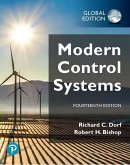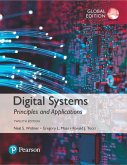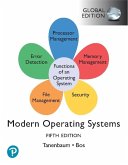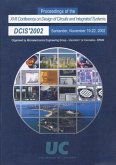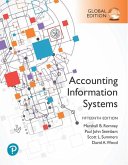Automation, Production Systems, and Computer-Integrated Manufacturing is appropriate for advanced undergraduate/ graduate-level courses in Automation, Production Systems, and Computer-Integrated Manufacturing.
This exploration of the technical and engineering aspects of automated production systems provides the most advanced, comprehensive, and balanced coverage of the subject of any text on the market. It covers all the major cutting-edge technologies of production automation and material handling, and how these technologies are used to construct modern manufacturing systems.
Teaching and Learning Experience
This book will provide a better teaching and learning experience—for you and your students. It will help:
Provide Balanced Coverage of Automated Production Systems: A quantitative approach provides numerous equations and example problems for instructors who want to include analytical and quantitative material in their courses.
Support Learning: End-of-chapter problems, review questions, and problem exercises give students plenty of opportunities to put theory into action.
Keep Your Course Current: This edition provides up-to-date coverage of production systems, how they are sometimes automated and computerized, and how they can be mathematically analyzed to obtain performance metrics.
Features + Benefits
Provide Balanced Coverage of Automated Production Systems
A quantitative approach provides numerous equations and example problems for instructors who want to include analytical and quantitative material in their courses.
“What the Equations Tell Us” statements follow the mathematical derivations and engineering equations. These statements list the practical meanings of the equations and guidelines regarding applications.
Support Learning
End-of-chapter problems enable instructors to assign problems in class rather than design these problems themselves.
Review questions and problem exercises are included at the end of every chapter.
Application guidelines are included in several of the descriptions of the technologies.
Historical notes and vignettes describe the development and historical background of the automation technologies.
Numerous example problems (covering several problem types) are covered in the end-of-chapter exercises.
The Instructor Solutions Manual contains answers to all of the review questions and solutions to all problems.
A complete set of PowerPoint® slides is provided for each chapter. The slides include most of the figures in the text.
NEW: More than 50% of the end-of-chapter problems are new or revised. The total number of problems is increased from 393 in the third edition to 416 in this edition.
NEW: An appendix has been added listing answers to selected end-of-chapter problems (answers to a total of 88 problems, or 21% of the end-of-chapter problems).*
NEW: A total of 36 new or revised figures are included in this new edition, for a total of 278 figures.
NEW: A list of abbreviations used in the book, located in the inside front cover, has been added for readers’ reference.
Keep Your Course Current
NEW: In Chapter 3, Manufacturing Metrics and Economics, many of the equations have been revised to make them more robust. A new section on cost of a manufactured part has been added.
NEW: In Chapter 6, Hardware Components for Automation and Process Control, new content has been added on electric motors, including linear motors and the conversion of rotary motion to linear motion.* Several new figures have been added in support of the new content.*
NEW: In Chapter 7, Computer Numerical Control, the appendix on APT has been removed because this method of programming has been largely replaced in industry by CAD/CAM part programming, coverage of which has been expanded in this new edition. In addition, the mathematical models of positioning control have been improved.
NEW: In Chapter 8, Industrial Robotics, two new robot configurations have been added and two configurations have been eliminated because they are no longer relevant.
NEW: In Chapter 9, Discrete Control and Programmable Logic Controllers, corrections and improvements have been made in the ladder logic examples.* A section on programmable automation controllers had been added.
UPDATED: In Chapter 10, Material Transport Systems, the section on AGVS technologies has been updated.
UPDATED: In Chapter 11, Storage Systems, the section on automated storage/retrieval systems has been updated and shortened.*
NEW: In Chapter 12, Automatic Identification and Data Capture, the section on radio frequency identification (RFID) has been expanded and updated.*
NEW: In Chapter 14, Single-Station Manufacturing Cells, coverage of CNC machining centers and related machine tools has been expanded.
UPDATED: In Chapter 15, Manual Assembly Lines, coverage of mixed-model assembly lines has been moved to an appendix, on the assumption that some instructors may not want to include this topic in their courses. A new section on batch-model assembly lines has been included in the appendix.
UPDATED: In Chapter 16, Automated Production Lines, coverage of transfer lines with internal parts storage has been moved to an appendix, on the assumption that some instructors may not want to include this topic in their courses.
NEW: In Chapter 18, Group Technology and Cellular Manufacturing, the organization of the text has been substantially revised. A new section on performance metrics in cell operations has been added. Coverage of parts classification and coding has been reduced, and the Opitz system has been relocated to an appendix.
NEW: In Chapter 19, Flexible Manufacturing Cells and Systems, sections on mass customization, reconfigurable manufacturing systems, and agile manufacturing have been added.
UPDATED: In Chapter 20, Quality Programs for Manufacturing, the DMAIC procedure in Six Sigma has been relocated to an appendix, on the assumption that some instructors may not want to cover the detailed methodology of Six Sigma. If they do, those details are in the appendix.
UPDATED: In Chapter 22, Inspection Technologies, the mathematical details of coordinate metrology have been relocated to an appendix. The section on machine vision has been updated to include recent advances in camera technology.
UPDATED: In Chapter 23, Product Design and CAD/CAM in the Production System, the section on CAD has been updated to be consistent with modern industrial practice.*
UPDATED: In Chapter 25, Production Planning and Control Systems, the section on work-in-process inventory costs has been eliminated, and the sections on MRP II and ERP have been upgraded.
Items marked with an asterisk (*) relate to recommendations made by the reviewers.
Automation, Production Systems, and Computer-Integrated Manufacturing is appropriate for advanced undergraduate/ graduate-level courses in Automation, Production Systems, and Computer-Integrated Manufacturing. This exploration of the technical and engineering aspects of automated production systems provides the most advanced, comprehensive, and balanced coverage of the subject of any text on the market. It covers all the major cutting-edge technologies of production automation and material handling, and how these technologies are used to construct modern manufacturing systems. Teaching and Learning Experience This book will provide a better teaching and learning experience?for you and your students. It will help: * Provide Balanced Coverage of Automated Production Systems: A quantitative approach provides numerous equations and example problems for instructors who want to include analytical and quantitative material in their courses. * Support Learning: End-of-chapter problems, review questions, and problem exercises give students plenty of opportunities to put theory into action. * Keep Your Course Current: This edition provides up-to-date coverage of production systems, how they are sometimes automated and computerized, and how they can be mathematically analyzed to obtain performance metrics.
This exploration of the technical and engineering aspects of automated production systems provides the most advanced, comprehensive, and balanced coverage of the subject of any text on the market. It covers all the major cutting-edge technologies of production automation and material handling, and how these technologies are used to construct modern manufacturing systems.
Teaching and Learning Experience
This book will provide a better teaching and learning experience—for you and your students. It will help:
Provide Balanced Coverage of Automated Production Systems: A quantitative approach provides numerous equations and example problems for instructors who want to include analytical and quantitative material in their courses.
Support Learning: End-of-chapter problems, review questions, and problem exercises give students plenty of opportunities to put theory into action.
Keep Your Course Current: This edition provides up-to-date coverage of production systems, how they are sometimes automated and computerized, and how they can be mathematically analyzed to obtain performance metrics.
Features + Benefits
Provide Balanced Coverage of Automated Production Systems
A quantitative approach provides numerous equations and example problems for instructors who want to include analytical and quantitative material in their courses.
“What the Equations Tell Us” statements follow the mathematical derivations and engineering equations. These statements list the practical meanings of the equations and guidelines regarding applications.
Support Learning
End-of-chapter problems enable instructors to assign problems in class rather than design these problems themselves.
Review questions and problem exercises are included at the end of every chapter.
Application guidelines are included in several of the descriptions of the technologies.
Historical notes and vignettes describe the development and historical background of the automation technologies.
Numerous example problems (covering several problem types) are covered in the end-of-chapter exercises.
The Instructor Solutions Manual contains answers to all of the review questions and solutions to all problems.
A complete set of PowerPoint® slides is provided for each chapter. The slides include most of the figures in the text.
NEW: More than 50% of the end-of-chapter problems are new or revised. The total number of problems is increased from 393 in the third edition to 416 in this edition.
NEW: An appendix has been added listing answers to selected end-of-chapter problems (answers to a total of 88 problems, or 21% of the end-of-chapter problems).*
NEW: A total of 36 new or revised figures are included in this new edition, for a total of 278 figures.
NEW: A list of abbreviations used in the book, located in the inside front cover, has been added for readers’ reference.
Keep Your Course Current
NEW: In Chapter 3, Manufacturing Metrics and Economics, many of the equations have been revised to make them more robust. A new section on cost of a manufactured part has been added.
NEW: In Chapter 6, Hardware Components for Automation and Process Control, new content has been added on electric motors, including linear motors and the conversion of rotary motion to linear motion.* Several new figures have been added in support of the new content.*
NEW: In Chapter 7, Computer Numerical Control, the appendix on APT has been removed because this method of programming has been largely replaced in industry by CAD/CAM part programming, coverage of which has been expanded in this new edition. In addition, the mathematical models of positioning control have been improved.
NEW: In Chapter 8, Industrial Robotics, two new robot configurations have been added and two configurations have been eliminated because they are no longer relevant.
NEW: In Chapter 9, Discrete Control and Programmable Logic Controllers, corrections and improvements have been made in the ladder logic examples.* A section on programmable automation controllers had been added.
UPDATED: In Chapter 10, Material Transport Systems, the section on AGVS technologies has been updated.
UPDATED: In Chapter 11, Storage Systems, the section on automated storage/retrieval systems has been updated and shortened.*
NEW: In Chapter 12, Automatic Identification and Data Capture, the section on radio frequency identification (RFID) has been expanded and updated.*
NEW: In Chapter 14, Single-Station Manufacturing Cells, coverage of CNC machining centers and related machine tools has been expanded.
UPDATED: In Chapter 15, Manual Assembly Lines, coverage of mixed-model assembly lines has been moved to an appendix, on the assumption that some instructors may not want to include this topic in their courses. A new section on batch-model assembly lines has been included in the appendix.
UPDATED: In Chapter 16, Automated Production Lines, coverage of transfer lines with internal parts storage has been moved to an appendix, on the assumption that some instructors may not want to include this topic in their courses.
NEW: In Chapter 18, Group Technology and Cellular Manufacturing, the organization of the text has been substantially revised. A new section on performance metrics in cell operations has been added. Coverage of parts classification and coding has been reduced, and the Opitz system has been relocated to an appendix.
NEW: In Chapter 19, Flexible Manufacturing Cells and Systems, sections on mass customization, reconfigurable manufacturing systems, and agile manufacturing have been added.
UPDATED: In Chapter 20, Quality Programs for Manufacturing, the DMAIC procedure in Six Sigma has been relocated to an appendix, on the assumption that some instructors may not want to cover the detailed methodology of Six Sigma. If they do, those details are in the appendix.
UPDATED: In Chapter 22, Inspection Technologies, the mathematical details of coordinate metrology have been relocated to an appendix. The section on machine vision has been updated to include recent advances in camera technology.
UPDATED: In Chapter 23, Product Design and CAD/CAM in the Production System, the section on CAD has been updated to be consistent with modern industrial practice.*
UPDATED: In Chapter 25, Production Planning and Control Systems, the section on work-in-process inventory costs has been eliminated, and the sections on MRP II and ERP have been upgraded.
Items marked with an asterisk (*) relate to recommendations made by the reviewers.
Automation, Production Systems, and Computer-Integrated Manufacturing is appropriate for advanced undergraduate/ graduate-level courses in Automation, Production Systems, and Computer-Integrated Manufacturing. This exploration of the technical and engineering aspects of automated production systems provides the most advanced, comprehensive, and balanced coverage of the subject of any text on the market. It covers all the major cutting-edge technologies of production automation and material handling, and how these technologies are used to construct modern manufacturing systems. Teaching and Learning Experience This book will provide a better teaching and learning experience?for you and your students. It will help: * Provide Balanced Coverage of Automated Production Systems: A quantitative approach provides numerous equations and example problems for instructors who want to include analytical and quantitative material in their courses. * Support Learning: End-of-chapter problems, review questions, and problem exercises give students plenty of opportunities to put theory into action. * Keep Your Course Current: This edition provides up-to-date coverage of production systems, how they are sometimes automated and computerized, and how they can be mathematically analyzed to obtain performance metrics.


